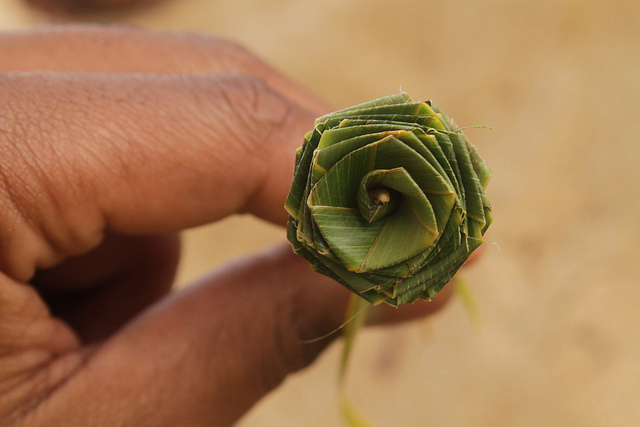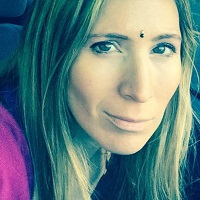
Paints. Brushes. Paper. Glue. Thread. Stickers. Pencils. Buttons. Canvas.
I have a slew of arts supplies in all nooks of my home, bins under beds, masquerading as magazines to my husband yet, for me, they are collage materials awaiting their scissoring demise into re-purposed and re-envisioned masterpieces. My glue gun lingers next to my hairdryer, when half-asleep, well…we know what happens next.
Art supplies. They are oxygen for a mother of little ones, to a creative heart-soul artist, expressive arts therapist and arts activist. All three roles intertwine as my core Self, spiraling and weaving in the unfolding of a creative life that attempts to make meaning each day.
For me amidst an often chaotic urban, commuter, householder lifestyle, running from meeting to bath-time, Bay Bridge to Golden Gate, the only bridge that actually links land of calm and chaos in this hot mess is Nature with a capital M for the “Mama-I-need-you-so-badly” kind of nature. It’s my go-to yoga practice and my psychological medicine. It is accessible, inevitable and reparative.
Nature asks nothing of us, except to co-create and commune, which we so deeply need these days.
Art is expression, alchemical communing, a process that changes us irreversibly. Expression through nature—inner nature meeting outer nature—becomes this dance.
But is there really an inner and outer after all? We are made of the elements. And when we walk around too long, acting, thinking and perceiving we are separate, behaving as if we are not made of earth, we lose our connectivity. Creating art with earth is making bread, dancing outside, using natural materials in the environment itself, or bringing them as treasures to your art table to see what manifests. So many possibilities and it truly doesn’t requires much scheduling, cost, training, or even time.
There are times when I’ve been so lost in a day’s work, drained from connecting to computers, disconnecting from others, inadvertently neglecting the nourishing of my mind and soul, that I have literally fallen to my knees on a mound of sand near the beach I live, having pulled over without texting my partner to explain why I am running late to get dinner or baths going for the kids. At these moments, I can’t bear another moment of living in my head, in past thoughts or future worries.
On this day in particular, I began scanning my body and environment: how the crunching sand felt on my knees, a slightly irritating discomfort that made me confront aliveness. The breeze on my right cheek nudged my awareness in the direction of the sea, where I saw a dead stingray. My first instinct was to encircle him, dragging my bare toes and heels into the wet, cool sand to begin a funeral rite. I gathered sea brush, the driftwood of the sea that was carried to shore in participation, like offering flowers to the dead. I gathered sea grass of brick-colored hues and deep grass greens and lined them along the mandala (circle) I had drawn with the intentionality of a child trying her best to color in the lines, perhaps to do this dead being justice.
I walked a few dozen feet off the shoreline to pick beach flowers of pink and yellow. People walked by processionally, as if they were paying respects without knowing it yet, their presence syncopated with curious thoughts catching up to their breaths. When I finished my funeral mandala, I sat on the edge of the circle and began to feel a warmth fill my belly, contrasting with my heart slowing to a gentler rhythm. I closed my eyes, chanted a little mantra I learned for safe passage to the next journey and only after that, began to summarize what had been happening, finally pulling my mindfulness into an analytical thought process.
For 10 or 15 minutes I had suspended the life of chaos and lived in the flow of things. A heart-warming oasis in the day that re-connected me to my Self. But the thoughts came cascading, as they do. Why do we ritualize death? Why create art around a creature at all? Why participate at all?
The existential weight lifted like a balloon cut loose. Why not is the only answer that let it go.
We create to make sense of destruction, to honor death with the life once lived. To breathe life into a potentially rote or stale day, or joy into a depressed state. It is our human impulse to make meaning, move things around, resurrect, re-frame, re-envison, re-create, re-join.
Walking away, I knew the sea would swallow the mandala and the stingray, leaving no trace of who was there or what had manifested between us, him, the witnesses. Mother nature never lets us forget the impermanence of things, or our place in them, which is her gift.
The goal of using the arts for healing is to use the materials as a bridge between inner and outer worlds—to connect via the senses and spirit in a way that one’s mental images, including emotions, feelings as well as spirit, can unfold towards healing and a final expression in art that can be witnessed. Compassionate witnessing catalyzes inner healing and the person witnessing is transformed too.
Have you ever looked at an art piece and thought, “Wow?” We stand in awe of graffiti on street corners, which reminds us of that song we heard, then we begin to sing and feel our breath moving through our feet, walking and observing, feeling one or at least together with that which surrounds us. That is co-creating, the art of living.
Art has heART doesn’t it? Just like the symbolic heart, it’s messy in a good way: full of of anger, joy, sadness, silliness and emotions we can’t even name, just feel. Communion rather than communication. We need to remember ourselves, literally re-join the limbs of heart and soul with the body of elements, and that means returning to the Earth.
In a time when computers, tablets and smartphones dominate our communication patterns and energetic output, we need the earth now more than ever. Technology has its place and it’s a boon to our society, no doubt. However, more time in traditional offices, schools, hospitals and subway stations, combined with technology, means more and more of us are losing our harmonious connection to mother earth. And without a deeply personal connection—to where our food is cultivated, earth–to-belly, to what our vehicles, planes and phones and chemical-laden products do to threaten our very own existence, including other living creatures and eco-systems—then it’s very hard to care enough to treat the earth better.
How do we connect? When we don’t have or feel the connection to our origins, where we came from, it’s hard to care about the future or what we need to sustain or for future generations to sustain. That’s where nature art comes in. You don’t have to go far to find a piece of nature. It’s everywhere, even if sandwiched or pushed to the edges of a concrete jungle.
Cultivating mindful awareness means we don’t just look, we see. What textures do we notice? What shapes? What sizes? What patterns? What can we smell? If we close our eyes, we may smell more than one fragrance. What can we feel viscerally with our hands? What do our hands feel like when they touch each other? What does it taste like—the ocean, honeysuckle, strawberries or fennel? What’s growing in our environment? It finds a way to grow, doesn’t it?
When we work with the earth, barefoot and with our hands, it re-grounds our minds. The pressure points in our feet and hands get massaged and can remedy or ameliorate anxiety and depression symptoms. There are many things in our communities to be feeling imbalanced about, including the destructive habits towards mother earth, but we can use the earth to heal our minds. And by healing our minds, we raise our own consciousness, which is connected to the earth and therefore move towards the right action.
In both the US and internationally, I work with children and women in particular to engage them in a therapeutic way with mother earth to create nature mandalas. It is deeply healing work, though not always visible on the surface of things. But slowly, the magic manifests in subtle ways.
Here is a simple nature art mandala that we can all do at home:
Using some colorful spices, turmeric, paprika, sea salt, thyme and other seasonings, create a mandala on your clean counter. Then combine them in the spirit of all-things-impermanent and like an alchemist, turn your art into cooking. Add this art mandala, with the healing intention of recycling your art, to your next nourishing recipe. Surprise yourself with new flavor combinations or if that’s not your taste, then there is no recipe to repeat, right? Zen mind.
You don’t have to be an artist or an arts therapist to make a nature mandala. Go outside, re-ignite your creativity, teach your partners, children and friends why it matters, and connect mindfully with our earth. She’s all we got and she needs us, too.
Author: Ali Guida
Editor: Nicole Cameron
Image: Zack Cartwright/Flickr






Read 0 comments and reply